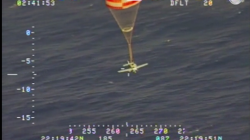Welcome to the first post of the Ask the Pilot series!
This week, Captain Josh will answer your airplane safety questions. Our first two questions will have to do with safety concerns during flight. When should you freak out and when should you just order another drink? The short answer is, you should never freak out. Now, go enjoy that next drink 😛
Can Emergence Exit Doors be Opened Once the Aircraft is Airborne?
We have all heard the stories. It seems that every few months or so we read a news article about some crazy person who loses it and tries to open the airplane emergency exit doors during flight. These stories usually end with the subject being tackled by the other passengers and we never really find out about what would have happened if he was successful in opening the emergency door. But what if that nut wasn’t restrained in time? Will the door blow off like in every action flick we have seen? Will the culprit be immediately sucked out of the cabin causing the airplane to do a nosedive into the Blue Lagoon? Or will the aircraft continue to fly normally as if it were on a Sunday afternoon drive with the windows rolled down?
Captain Josh explains. Emergency exit doors in aircraft obviously serve an important and specific function. Aircraft manufacturers include a certain number of exit doors and strategically place them in the aircraft in order to evacuate the entire aircraft in a specified amount of time. These emergency exit doors aren’t just extra doors placed in the middle of the aircraft. They have special sensors, slides and mechanical equipment to ensure proper operation during an emergency evacuation.
One of the components of the emergency exit system is a mechanical lock which engages once the aircraft is traveling above a certain speed. This prevents the curious passenger from attempting to open the emergency exit door while the aircraft is airborne or still moving on the ground. Additionally, certain emergency exit doors are designed to open inward, before opening outward. Once airborne, the air pressure inside the cabin becomes greater than the air pressure outside of the aircraft, it becomes physically impossible for a man of average or even above average strength to open those doors. That being said, emergency exit doors are always secured by mechanical locks so you won’t have to worry about it. And remember, the nearest emergency exit may be behind you!
Can Two Engine Aircraft Fly Safely on One Engine?
As jet fuel becomes more and more expensive and airplane engines become more powerful and fuel efficient, the trend in the aircraft manufacturing industry has been to design new aircraft with two engines as opposed to four. Engine manufacturers have continued to increase the reliability of commercial jet engines and in-flight engine malfunctions or failures are incredibly rare. Two-engine “overwater” operations are governed by ETOPS, Extended Twin-Engine Overwater Operations, regulations and airlines have to receive specific authorization for these types of operations. In order for an airline to receive this special type of authorization, the airline has to prove that they not only have an effective maintenance program in place to support this type of operation, but they also have to prove through their safety record that their engine-failure rate is below a certain ratio.
Despite this incredible safety record, engine malfunctions do happen and pilots are specifically trained to be able to fly two-engine airplanes on one operating engine. Additionally, aircraft go through stringent certification procedures and manufacturers have to demonstrate that the aircraft can safely fly on one engine for extended periods of time. Then if you are training to become a pilot you should have a look at the most realistic flight simulator experiences that are available, as they will give you that realistic experience that you need. While the vast majority of passengers will never experience an engine malfunction, rest assured that you are safe and in good hands should you encounter one of these rare events.



